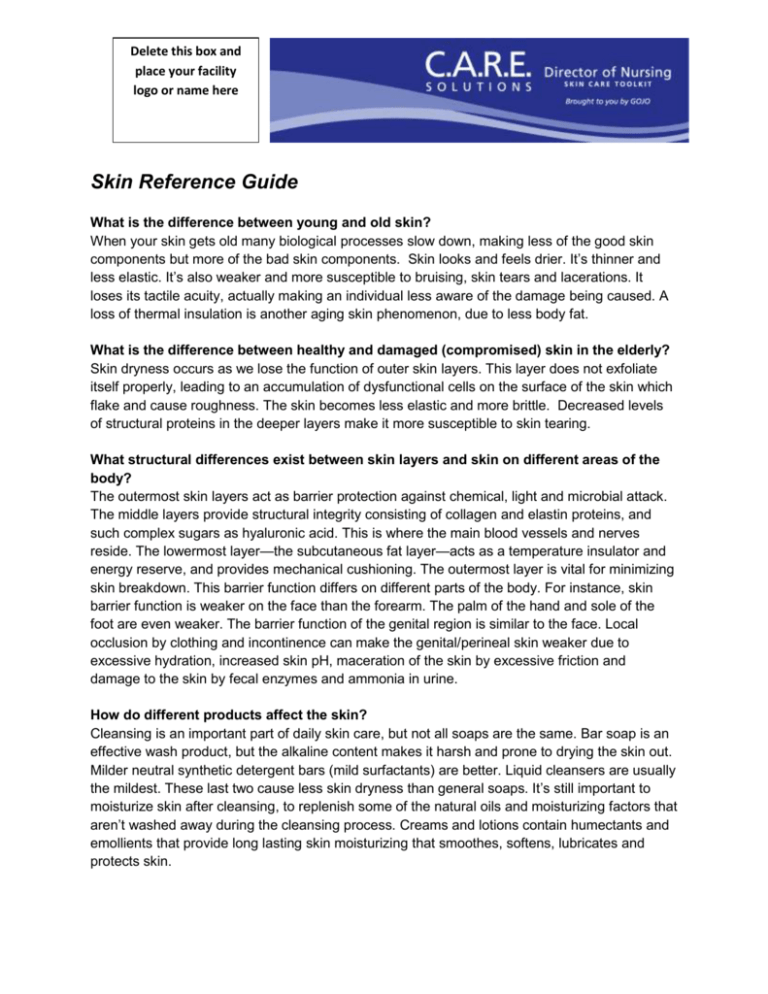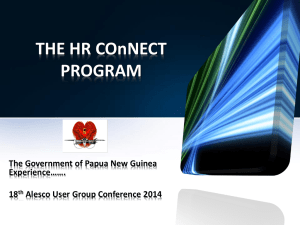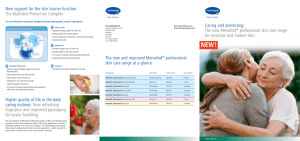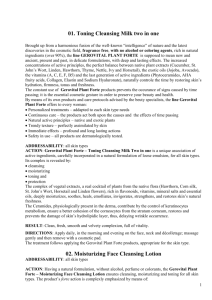Skin Reference Guide
advertisement

Delete this box and place your facility logo or name here Skin Reference Guide What is the difference between young and old skin? When your skin gets old many biological processes slow down, making less of the good skin components but more of the bad skin components. Skin looks and feels drier. It’s thinner and less elastic. It’s also weaker and more susceptible to bruising, skin tears and lacerations. It loses its tactile acuity, actually making an individual less aware of the damage being caused. A loss of thermal insulation is another aging skin phenomenon, due to less body fat. What is the difference between healthy and damaged (compromised) skin in the elderly? Skin dryness occurs as we lose the function of outer skin layers. This layer does not exfoliate itself properly, leading to an accumulation of dysfunctional cells on the surface of the skin which flake and cause roughness. The skin becomes less elastic and more brittle. Decreased levels of structural proteins in the deeper layers make it more susceptible to skin tearing. What structural differences exist between skin layers and skin on different areas of the body? The outermost skin layers act as barrier protection against chemical, light and microbial attack. The middle layers provide structural integrity consisting of collagen and elastin proteins, and such complex sugars as hyaluronic acid. This is where the main blood vessels and nerves reside. The lowermost layer—the subcutaneous fat layer—acts as a temperature insulator and energy reserve, and provides mechanical cushioning. The outermost layer is vital for minimizing skin breakdown. This barrier function differs on different parts of the body. For instance, skin barrier function is weaker on the face than the forearm. The palm of the hand and sole of the foot are even weaker. The barrier function of the genital region is similar to the face. Local occlusion by clothing and incontinence can make the genital/perineal skin weaker due to excessive hydration, increased skin pH, maceration of the skin by excessive friction and damage to the skin by fecal enzymes and ammonia in urine. How do different products affect the skin? Cleansing is an important part of daily skin care, but not all soaps are the same. Bar soap is an effective wash product, but the alkaline content makes it harsh and prone to drying the skin out. Milder neutral synthetic detergent bars (mild surfactants) are better. Liquid cleansers are usually the mildest. These last two cause less skin dryness than general soaps. It’s still important to moisturize skin after cleansing, to replenish some of the natural oils and moisturizing factors that aren’t washed away during the cleansing process. Creams and lotions contain humectants and emollients that provide long lasting skin moisturizing that smoothes, softens, lubricates and protects skin. Delete this box and place your facility logo or name here How does minor skin irritation present itself? What is the process of damage? Skin can become easily irritated. Although the outer layers provide barrier protection, it’s not impenetrable. Once breached, irritant chemicals damage the living skin cells. They, in turn, produce their own chemicals that initiate the inflammatory processes. Skin will look red and inflamed. Skin will become itchy and scratching can make the problem worse. Abrading the skin surface layers can lead to a greater risk of infection. How does diabetes and other vascular diseases affect skin health? Dry, scaly skin is often observed in diabetic patients. Insulin resistance and hyperglycemia can increase skin thickness and stiffness and cause delayed wound healing. Patients suffer from a generalized skin itching. Skin breakdown with ulcer and chronic wound formation is a frequent consequence of these diseases. When is the best time to apply lotion? Moisturizing lotions should be applied twice daily, or more frequently depending on the severity of the condition and the type of moisturizing product. Product is best applied immediately after the cleansing routine, when the skin is well hydrated. What is the best way to wash/cleanse elderly skin without damage? It’s very important to apply moisturizers and cleansers gently. The diminished skin integrity that occurs with age needs careful consideration. Soft cloths or sponges can be used, but not vigorously. Should I wash the face with soap, or is water cleansing alright for elderly residents? Washing with water alone will not effectively cleanse the face. Gentle moisturizing soaps or liquid cleansers should be used. My product does not foam up – is it still cleansing? A good lather has become embedded in our brains as a good cleanser. However good-foaming cleansers can sometimes be harsh. It’s not necessary for a cleanser to offer a thick foam for it to perform its purpose of cleansing skin. What makes a person at risk for skin problems? Skin processes slow down as we age, making the skin weaker and more susceptible to dryness. The situation is more serious for diabetics. Due to the reduced feeling that occurs in the skin with advancing age, and frequent mechanical trauma, skin tears can be a problem. Poor nutrition can exacerbate these problems as wound healing becomes reduced. What are the first noticeable changes as skin problems develop? Skin dryness will appear as whitish flakes on the skin surface. Reduced hydration of these outer layers leads to an itching sensation. Burning, stinging sensations are felt on the face, and skin Delete this box and place your facility logo or name here tightness sensations can occur on any body site. Scratching to alleviate the itching sensations can cause mechanical damage to the skin, leading to inflammation. What areas are prone to what type of skin problems? Skin dryness can occur on all body sites. Skin itching is especially known to occur on the torso. Feelings of skin tightness and burning occur on facial skin. Skin thinning occurs on all body sites but bruising occurs on the extremities, especially on the arms. Ulcers occur in the lower extremities, but pressure ulcers occur on any part of the body subject to pressure. What are the top things I can do to prevent skin problems from occurring? Gentle, mild cleansing in lukewarm water and moisturize twice a day (more frequently if needed) can be helpful. Use a moisturizer with sunscreen when outdoors, maintain a healthy diet and drink plenty of fluids. Are 'no-rinse' products really alright to use and leave on people’s skin? Some no-rinse cleansing products can contain harsh surfactants which can damage the skin if left on the skin’s surface, and are not recommended. Others however, are much gentler. PROVON 3~in~1 Wash Cream is a gentle, no-rinse alternative to soap and water. It leaves the skin clean, conditioned and fresh smelling. PROVON 3~in~1 Wash Cream rapidly removes urine and feces to help ensure effective skin cleansing. It’s safe and gentle, it can help reduces the risk of skin irritation and breakdown, and is specially formulated for delicate skin. It contains fresh herbal fragrance, contains aloe and vitamin E and is pH balanced. When it comes to products isn't “more” always better? Not necessarily. Creams and lotions should be applied frequently, but the dosage should only be enough to lightly layer the skin. Thick heavy applications can be too occlusive, which can have a detrimental effect on the skin. How will I know if a particular product is good or bad for my resident's skin? Careful observation will assess whether products are compatible or not. If you detect redness or irritation, stop using the product and try a gentler one. How does a barrier product work on an incontinent person, and should it be completely washed off between incontinent episodes? A barrier product provides skin protection against the damaging effects of excreted material. It’s important to first completely remove the urine and fecal material by cleansing. Also, petrolatum can be washed off easily and reapplied. This is why PROVON Perineal skin protectant with either 60% petrolatum or 99% petrolatum is an ideal temporary barrier for intact skin. Zinc oxide-containing barrier creams can be more difficult to remove and the integrity of the skin needs to be considered in removing these as the skin’s barrier may be further broken. Why is it so important to keep the skin on legs and feet in good condition? Skin dryness can occur on all body sites, but legs and feet are especially prone sites. On the legs, exposure to the weather and sunlight is the predominant factors as well as damage from repetitive trauma. Due to the full impact of body weight, feet come under tremendous wear and tear. Hard skin such as calluses can develop. This is a normal response but when the skin is thickened it can crack and cause pain. These can also be sites of ulcer formation. Delete this box and place your facility logo or name here We only shower a person twice a week, with a partial bedside bath in between. Is that really enough to keep the skin healthy? Twice per week is okay as long as cleansing is done at the beside to refresh the skin. Always moisturize afterwards. Some patients may require a greater frequency of showering if they have greater incontinence problems. Also be aware of body odor. How frequently should I be checking for skin problems? Daily, but for prevention of pressure ulcers the accepted standard of care is to turn the patient every two hours. How fast can a pressure ulcer develop? The damage causing a pressure ulcer can occur within hours. That’s why it’s important to reposition patients and use special supports to redistribute the pressure on the skin. Preventing damp skin from fecal or urinary incontinence is also advised as it can cause maceration of the skin and result in skin infections. What are evidence-based claims and why are they important? Evidence-based claims relate to the clinical efficacy of products in relation to disease/problem outcomes. Often, clinicians are making purchase decisions outside of the simple price or aesthetics of a product. They are now also basing their assessments on the benefits of a product that has been examined in a robust clinical trial. PROVON Hand & Body Butter has undergone such a clinical study using state-of-the-art instrumentation to prove its moisturizing efficacy in a two-center nursing home study. Improvements in skin hydration and elasticity have been found in geriatric patients. This is the first time that GOJO has conducted such a robust study to show the effect of their product on both skin elasticity and hydration. These scientific findings help to confirm that use of the product can reduce the risk of additional skin breakdown.











